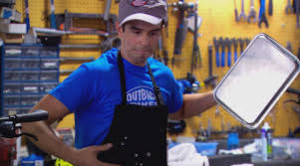On all grounds, legal and ethical, I should have been murdered for the Rubber Baby Joke.
The Rubber Baby Joke was borne of a documentary I saw as a kid on sharks. The show said that shark skeletons are made of cartilage, the sinewy gristle that comprises our noses and ears. Human baby bones, the show said, begin as cartilage until morphing into bone to cover vital organs like the lungs and heart.
Because I’m a genetic asshole, I immediately trotted to my sister, who would have been a Littler Kid, to tell her that babies were born of cartilage. If fact, I pontificated like a drunk Jon Levitz, if you dropped a baby from a three-story window with the right amount of backspin, it would bounce unhurt up to the window ledge of a first-floor apartment. Er, why that’s why they’re called bouncing babies. That’s the ticket. 
Caroline, who would have made a far better reporter than I, did the smart thing. She never forgot the lie. If ever I windbag a story that begins to wax unlikely — I estimate 137% of the time — she will ask “Is this a bouncing baby story?”
https://www.youtube.com/watch?v=0NvtR63Ks-g
I’ve always wondered from where that jackass humor sprang. I’d like to blame it on a parent. But mom presented me with strong evidence recently that there may be a sonofabitch gene: The Carbonaro Effect. It’s a show featuring a second-rate magician with first-rate props, a Candid Camera in which subjects are lured on stage, which in the show’s case is anything from a fake crafts shop to a lumber yard.
There, Carbonaro will perform hilarious jokes: floating coffee cups, taxidermy turning real; a great hardware store skit where he suggests he’s been magnetized by an electric mishap; that’s why bikes keep sticking to him. Unlike my sister, suspicion is checked at the door. This, even though 90% of studies are 70% fake, statistics say. People need to believe. People need to know there’s a reason, however unreasonable the reason may be.
Like all good reality TV shows, the series works not for the jokes, but the subjects. When played correctly, reality show participants underscore a larger zeitgeist (Tosh 2.0 the prime example). In Carbonarao’s case, just just a little bit of rubber-baby logic does the trick: The coffee floated because, duh, heat rises. Water a dehydrated mouse, and it will no longer be snake food. He’s discovered: add a little logic, however skewed, and an audience will do the rest.
Perhaps that’s why magic is back. Carbonaro has gone syndicated; Penn & Teller’s Fool Us crossed the pond to American prime time; Now You See Me, an awful Morgan Freeman flick, was one of 2014’s biggest box office surprises.
The opposite should be true. Magic works best up close, without camera editing. Does anyone believe David Copperfield vanishes the statue of liberty?
Then again, perhaps it makes sense. About a third of Americans go to regular religious service, the lowest in history. Politics have become an As Seen on TV minstrel show. Perhaps, unlike pastors and politicians, a magician will tell you a lie is coming.
But, trust me on this, Mike, for your own health. Do not turn a baby to rubber.

